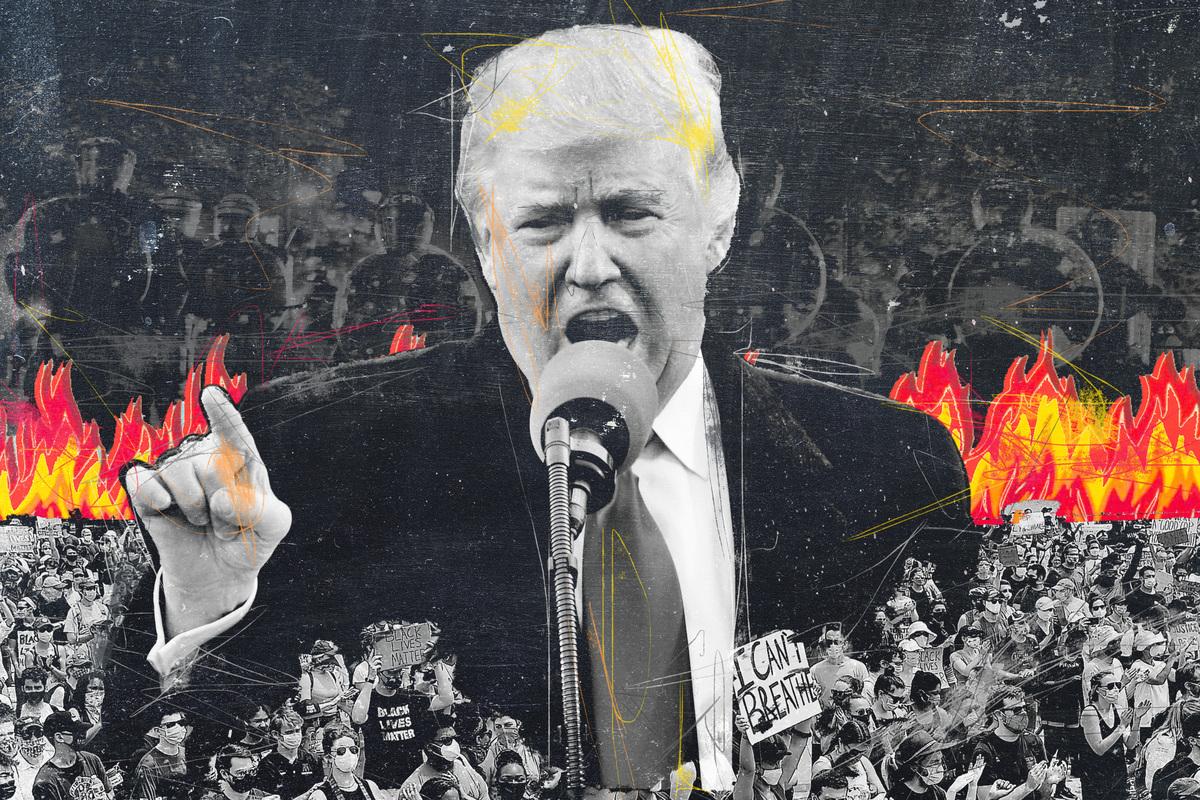
On January 20, 2017, Donald Trump stood in the rain on the U.S. Capitol steps to read his inaugural remarks, 1,433 words, cowritten with his most notorious advisers, Steve Bannon and Stephen Miller.
The speech and its theater made for a vivid reckoning: Trump described the “American carnage”—a litany of perceived setbacks in U.S. foreign policy, globalization, immigration, crime, and the culture wars—that culminated with his election as president. The humiliated political elites who opposed him—Hillary Clinton, Barack Obama, Joe Biden—sat behind him and space-time seemed to bend around him. George W. Bush, in a private aside to Clinton, memorialized Trump’s speech as “some weird shit.” Clinton recalled her own “out-of-body experience” sitting in the front row. The reports from the scene suggested so many regrets from those in attendance: Clinton’s failure to defeat Trump, Bush’s struggle to reconcile his own religious, sentimental style of politics—compassionate conservatism—with Trump’s dystopian flourishes. Trump launched his campaign with fear-mongering about Mexico pouring “drugs,” “crime,” and “rapists” into the U.S. In his inaugural address, Trump doubled down on his dismal rendering of Obama’s America: rusted industries, widespread poverty, ubiquitous violence. “This American carnage stops right here and stops right now,” Trump promised.
Trump defeated Clinton on the strength of his antiestablishmentarian upset. Clinton, Obama, Biden, Bush—these people had mismanaged the nation’s resources, materially and spiritually, for the past quarter-century. So, Trump argued, Obama’s America had unraveled into godless, cosmopolitan bedlam. Trump promised to lead a rustic restoration with his controversial slogans “Make America Great Again,” and “America First.” He promised unity, too. Despite his bloodthirsty political instincts, Trump pledged to reconcile the hyperpartisan factions, citing scripture in his inauguration speech, Psalm 133:1: “Behold, how good and how pleasant it is for brethren to dwell together in unity!” Meanwhile, Washington, D.C., hosted so many bold hints of disunity following his election: Trump’s speech itself; the Women’s March protesters dwarfing Trump’s inauguration turnout; Sean Spicer and Kellyanne Conway shouting at reporters about the news media’s political biases; the “alternative facts” about crowd sizes on the National Mall. And this—the week of January 20, 2017—was Trump’s high point.
Since then, Trump has overseen the sort of national unraveling that he’d otherwise attributed to his predecessors. Trump has, in some perverse sense, made good on the themes in his inaugural remarks: For the past three years, Trump has presided over the most prolonged and astonishing “American carnage” in more than half a century. It will end his presidency.
On July 15, 1979, Jimmy Carter sat before a TV camera in the Oval Office and addressed the country for 33 minutes in a live broadcast. He delivered his most memorable speech, titled “Crisis of Confidence,” in order to assuage the popular fears about the 1970s energy crisis and the subsequent economic stagnation. “It’s clear that the true problems of our nation are much deeper than gasoline lines or energy shortages, deeper even than inflation or recession,” Carter said. He went on to describe the national “crisis of confidence” as a crisis of consumption. “Human identity is no longer defined by what one does,” Carter said, “but by what one owns.” Carter sensed in the national character “a growing disrespect for government and for churches and for schools, the news media, and other institutions,” which had, Carter feared, become irrelevant in the citizen’s search for purpose and meaning. “This is not a message of happiness or reassurance,” Carter said, “but it is the truth and it is a warning.”
Sixteen months later, Ronald Reagan repudiated Carter’s pessimism, and his “Crisis of Confidence” speech in particular, in his presidential campaign announcement. “I find no national malaise,” Reagan said, “I find nothing wrong with the American people.” Here, Reagan saddled Carter’s speech with an alternative title, “the malaise speech.” In his “Crisis of Confidence,” Carter offered cold comfort, and Reagan reveled in Carter’s failures to raise the nation’s spirits in his reelection year. Now, Trump confronts a similar malaise, as “this American carnage” has consumed his reelection year. In his first presidential campaign, Trump exploited anxieties that he could never even begin to relieve, much less resolve. Trump is often compared to Richard Nixon, George Wallace, and Richard J. Daley—the midcentury figures who led (and now embody) the harshest counterreaction to civil rights activism. Trump wants to deploy U.S. troops to suppress left-wing protesters. He promises to restore the public order that has collapsed under his own watch. It’s tempting, but difficult to compare the civil rights crises in 1968 and 2020 beat for beat; the scale, diversity, and popularity of the ongoing protests against police brutality have proved altogether unprecedented. It’s easier to compare the party-line responses to such crises. Writing for The Atlantic, David Frum drew the distinction between Nixon, the original “law and order” presidential candidate, and Wallace, the segregationist provocateur, in order to cast Trump in Wallace’s shadow: “Trump is the force of disorder that is frightening American voters into seeking a healing candidate,” Frum writes, “not the candidate of healing who can restore a fair and just public order.”
Trump recalls the stern “law and order” posturing that reinforced Nixon as well as the cruelty that reinforced Daley and Wallace. But Trump even more so recalls the “malaise” that sabotaged Carter. Seventy-four percent of respondents in a recent Washington Post-Schar School survey support the ongoing protests against police brutality, and 61 percent of respondents in the same poll disapprove of Trump’s overall response to the demonstrations. Fifty-five percent of respondents in a recent NBC News/Wall Street Journal survey disapprove of Trump’s coronavirus response, and 80 percent of respondents in the same survey believe “things in the country are out of control.” Even the most naive, distracted, or charitable interpreter of Trump’s pronouncements about the concurrent crises—the civil rights protests, the coronavirus pandemic, and the subsequent economic collapse—would struggle to reconcile his stern direction with his destabilizing effect. Trump has never seemed more obviously helpless than when he’s deploying the National Guard and tear gas to disperse a peaceful demonstration across Lafayette Square in search of a photo op so bizarre that not even Pat Robertson could decipher its meaning. Tear-gassing peaceful protesters at Lafayette Square was an appalling act of state-sanctioned violence, and yet Trump’s photo op in front of St. John’s Episcopal Church was somehow more damning evidence of his uselessness in “this American carnage,” troops or no troops. What’s worse? Jimmy Carter consoling the country with unsuitable truths about consumerism, or Donald Trump consoling the country with unsuitable nonsense about ... well, where do you start? There’s no slogan, no chant, no nickname, no epithet, and no scripture that Trump can wield to dispel such a broad and complicated malaise, spun from tensions that predate him and a virus that ignores him. It’s not even Trump’s fault, strictly speaking. But it’s Trump’s America.

